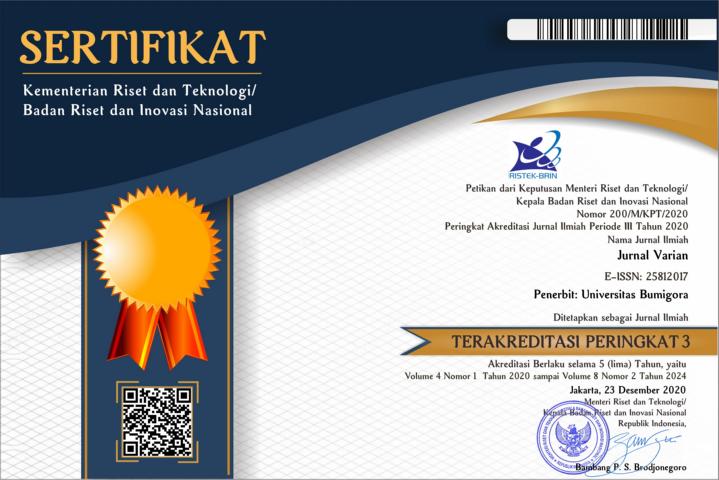Mathematical Modelling and Simulation Strategies for Controlling Damage to Forest Resources Due to Illegal Logging
Abstract
Forests are one of the natural resources that provide many benefits for the welfare of living things.
The dense population causes people to depend more on forest resources. One of them is illegal logging.
Various strategies to control forest damage due to illegal logging have been carried out, namely by direct
handling to improve damaged conditions while preventing the recurrence of forest damage. The purpose
of this research is to build a mathematical model of forest resource damage control strategies due to
illegal logging, determine assumptions, formulate the model, and conduct analysis and problem solving
including: determining the equilibrium point, determining the stability analysis of the equilibrium point,
and conducting numerical simulations of the equilibrium point. The last step is to interpret the results of
the analysis obtained and make conclusions. Based on the research and simulation results of the model,
it can be concluded that taking into account the variable of forest resource damage control strategy
due to illegal logging, the result shows that if the density of forest resources has been affected by the
disturbance of population density around the forest, it is necessary to have a forest resource damage
control strategy in order to compensate for the people around the forest who do a lot of illegal logging.
In order to maintain the forest so that the forest does not quickly become extinct and can overcome
drought, prevent flooding, maintain groundwater quality, protect animals, reduce air pollution, climate
control, reduce dust particles, prevent the greenhouse effect, supply natural fertilizers, prevent erosion,
and maintain springs.
References
https://doi.org/10.1016/j.padiff.2023.100609
Abi, M. M., Bano, E. N., Obe, L. F., & Blegur, F. M. A. (2023). Mathematical Modeling and Simulation of Social Media Addiction
TikTok Using SEI1I2R Type Model. Jurnal Diferensial, 5(1), 43–55. https://doi.org/10.35508/jd.v5i1.10401
Masdiana, M., Lalang, D., Sahamony, N. F., Astuty, S., Astuti, R., Nurmitasari, N., One, L., Bano, E. N., Adrianingsih, N. Y.,
Cahyadi, R., & Cahaya, A. B. (2022, September). Aljabar Linear Elementer. Penerbit Tahta Media. https://tahtamedia.
co.id/index.php/issj/article/view/964
Mohamad, R., Rauf, M. D. A., & Lakisa, N. (2019). Model Matematika Kerusakan Hutan dengan Memperhatikan Faktor Industri
dan Kebakaran. Euler : Jurnal Ilmiah Matematika, Sains dan Teknologi, 7(1), 6–14. https://doi.org/10.34312/euler.
v7i1.10328
Muhammad, F., Maryono, M., Hadiyanto, H., Retnaningsih, T., & Hastuti, R. B. (2023). Reboisasi sebagai Upaya Konservasi di
KHDTK Dipoforest Hutan Penggaron Kabupaten Semarang. Jurnal Pasopati, 5(1), 29–36. https://doi.org/10.14710/
pasopati.2023.17135
Munaqib, M. (2021). Lecture Module on Mathematical Modelling.
Ndii, M. Z. (2018). Mathematical Modelling - Population Dynamics and Disease Spread. Theory, Applications, and Numerical. CV Budi Utama.
Suci, N., Arnellis, & Rosha, M. (2014). Model Matematika Kerusakan Sumber Daya Hutan di Indonesia. Journal Of Mathematics
UNP, 2(1), 1–6. https://doi.org/10.24036/unpjomath.v2i1.1958
Suddin, S., Bano, E. N., & Yanni, M. H. (2021). Mathematical Modelling of Multidrug-Resistant Tuberculosis with Vaccination.
MATEMATIKA, 109–120. https://matematika.utm.my/index.php/matematika/article/view/1318
Sundra, I. K. (2017). Pengelolaan Sumber Daya Hutan. Fakultas Matematika dan Ilmu Pengetahuan Alam, Universitas
UDAYANA, Denpasar.
The Statistics Office of North Central Timor District. (2021). Population, area, and population density by sub-district in TTU district
2017-2019. https://timortengahutarakab.bps.go.id/id/statistics-table/2/NDEjMg==/penduduk-luas-wilayah-dan-kepadatanpenduduk-menurut-kecamatan-di-kabupaten-ttu.html
Wirmayanti, P. A. I., Widiati, I. A. P., & Arthanaya, I. W. (2021). Akibat Hukum Penebangan Hutan secara Liar. Jurnal Preferensi
Hukum, 2(1), 197–201. https://doi.org/10.22225/jph.2.1.3067.197-201
Wulandari, W., Darmawijoyo, D., & Hartono, Y. (2016). Pengaruh Pendekatan Pemodelan Matematika terhadap Kemampuan Argumentasi Siswa Kelas VIII SMP Negeri 15 Palembang. Jurnal Pendidikan Matematika Sriwijaya, 10(1), 114–126.
https://doi.org/10.22342/jpm.10.1.3292.111-123
Zainuddin, M., & Tahnur, M. (2018). Nilai Manfaat Ekonomi Hutan Kota Universitas Hasanuddin Makassar. Jurnal Hutan dan
Masyarakat, 10(2), 239. https://doi.org/10.24259/jhm.v10i2.4874

This work is licensed under a Creative Commons Attribution 4.0 International License.


















